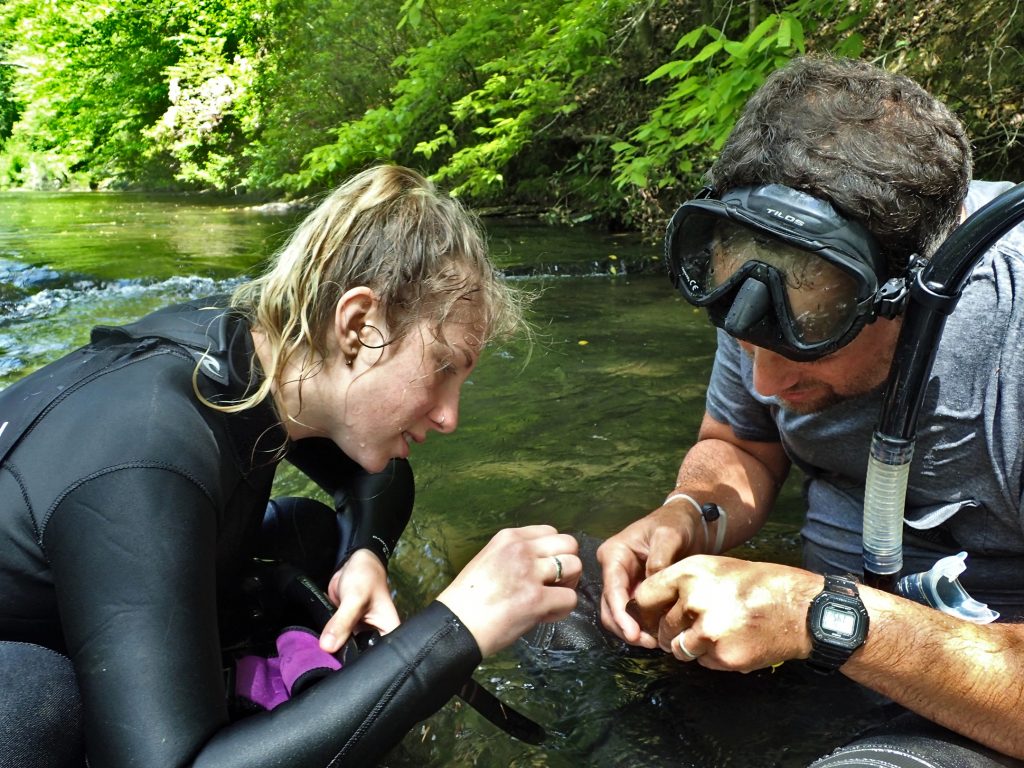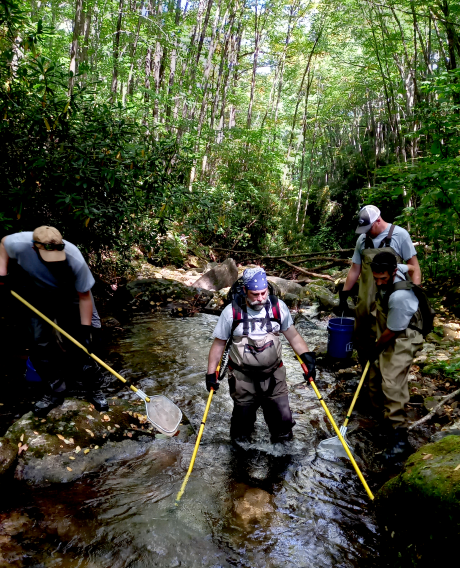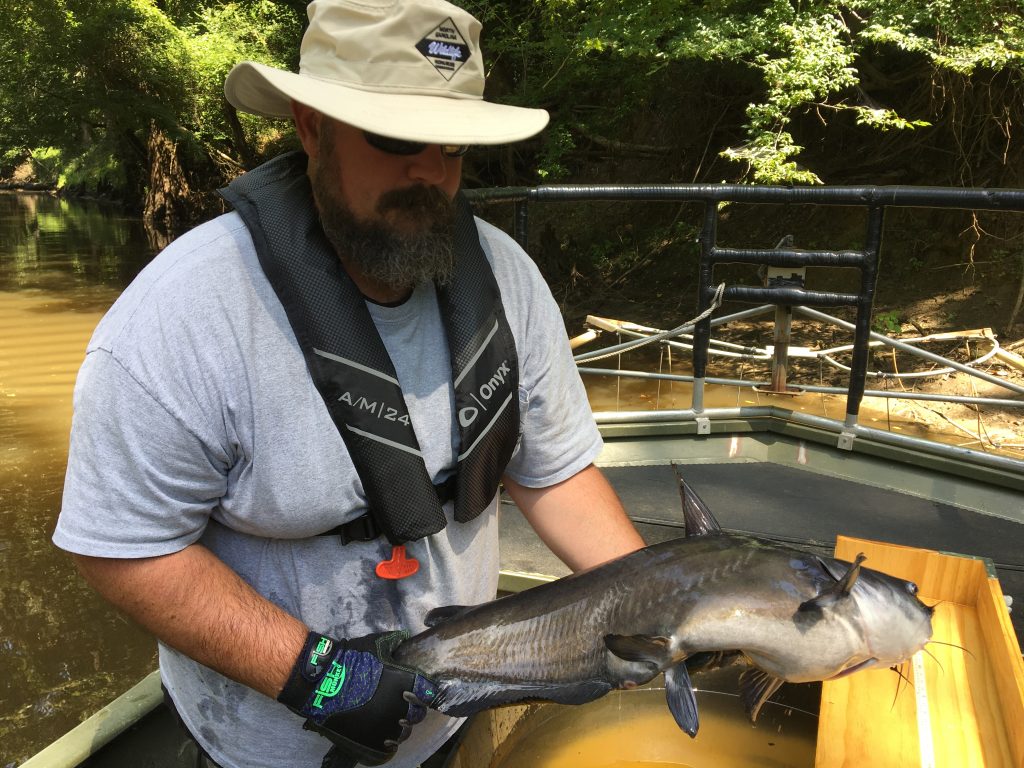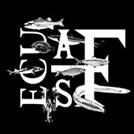Fall 2022 Newsletter

Quick Content Links
- President’s Message
- Treasurer’s Report
- Save the Date – 2023 NCAFS Annual Meeting!
- Back to School with Shad! 2022 Shad in the Classroom
- NC Fishes.com Team Updates
- Southern Flounder Research from the East Carolina University Student Subunit (ECU-AFS)
- A Photo Essay from NCWRC
- 2023 SDAFS Meeting
- Good Work! – Recent Publications by NCAFS Members
- Stories of Interest
- Call to Action!
- Valuable Links
President’s Message
We’re moving into autumn, and many of us are squeezing in as much as we can into the last of the warm weather field season. I’m hoping I can distract you to think about a couple of bigger picture opportunities today.
First – we’re coming down to the final steps in Congress to push through the Recovering America’s Wildlife Act (RAWA). If RAWA passed, it will mean that more than $20 million would be available to North Carolina alone to implement its Wildlife Action Plan. NC Wildlife Resources Commission intends use the funding to work with partners, volunteers, and others to manage and restore North Carolina’s Species of Greatest Conservation Need (SGCN), conserve and restore priority habitats, expand conservation education and stewardship, and more. RAWA has passed the US House, and it is now in the Senate. Both of North Carolina’s senators have pledged their support for RAWA, but they need our encouragement to stay the course – please contact Senator Tillis and Senator Burr to encourage them to vote to pass RAWA. Read this great article by the Colorado Backcountry Hunters and Anglers that was featured in NC Policy Watch and spread the good word: RAWA-BackcountryHunters&AnglersArticle.
Second – do you have a funding need? NCAFS has a healthy bank account, and we use our funds to support fisheries and aquatic resource-oriented projects. Funding proposals can be submitted twice per year – with the deadlines of April 1 and November 1. The November deadline is coming up fast, and it is the only time that both small (<$1,000) and large (>$1,000) funding requests can be made. See the funding application on our website at https://nc.fisheries.org/wp-content/uploads/2019/02/Funding-Request-Form-2019.pdf.
Happy Fall Equinox,
Andrea
Submitted by Andrea Leslie, NCAFS President
Treasurer’s Report
Balances as of September 6, 2022:
NCAFS Wells Fargo Checking Account: $10,521.04
RRCC Wells Fargo Saving Account: $7,124.75
Edward Jones Ichthus (Student) Fund: $29,485.67
Edward Jones General Fund: $69,272.86
We encourage groups or individuals to apply for project funding! Please fill out this application and send to Andrea Leslie ([email protected]) by November 1, 2022. Applications will be reviewed and notification of your application status will be given within 30-45 days of the deadline. An example of funding was highlighted in the Summer 2021 newsletter by Bryn Tracy and the NCFishes.com Team. The team was able to use funding from NCAFS to assist with travel expenses while photographing fish in Western NC.
For questions regarding finances, donations/awards, or procedures, please contact Casey Joubert at [email protected].
Submitted by Casey Joubert, NCAFS Secretary-Treasurer
Save the Date – 2023 NCAFS Annual Meeting!
The 34th annual meeting of the North Carolina Chapter of the American Fisheries Society will occur February 22-23 at the Millennium Hotel in Durham! Stay tuned for detailed information on the continuing education workshop, lodging, abstracts, and registration. A First Call for Papers will appear in your email inbox later this fall. If you have questions or would like to help plan and organize the meeting, please contact Kelsey Roberts ([email protected]).
Submitted by Kelsey Roberts, NCAFS President-Elect
Back to School with Shad! 2022 Shad in the Classroom

Exploris Elementary School students practice netting fish under the watchful eye of NCWRC’s Michael Fisk.
Through the Shad in the Classroom program, elementary, middle, and high school students learn concepts related to the American Shad’s survival, the species cultural and biological importance, its ecological connections to other species and habitats, and the significance of genetic integrity. Teachers also integrate various other disciplines into the program including math, social studies, technology, art, literacy, and writing. The program heightens knowledge and awareness in future generations of an important migratory fish.
The program goals incorporate a “hands-on” approach with raising shad and give the students a strong connection to the fish resource and the river basin. Program enhancement activities like the fish dissection lessons are highly valued by our students and teachers. The hands-on approach of these activities allows students to see, touch, and explore various fish species helping to more fully engage the students
The Shad in the Classroom Program continues to be a success due to its dedicated partners. The program is managed by the NC Museum of Natural Sciences (Museum) and receives significant logistical and financial support from the Albemarle-Pamlico National Estuary Partnership (APNEP), the North Carolina Wildlife Resources Commission (NCWRC), and the U.S. Fish and Wildlife Service (USFWS). North Carolina State University (NCSU), the NCSU Student Fisheries Society, and Eastern Carolina University (ECU) student subunit also play significant roles.

NCWRC biologist TD VanMiddlesworth gave a Zoom presentation describing American Shad monitoring efforts.
Happily, most schools were able to participate in person for the 2022 Shad year. Teacher orientation was still virtual this year and they were provided information about American Shad life history, restoration, and management. They received instructions for raising shad and learned ways to incorporate shad and aquatic ecology into their curriculum. TD VanMiddlesworth guest lectured on American Shad restoration and management. Many teachers commented that they liked hearing the updates on the shad management and the population status. Teacher also had the opportunity to build their own shad … shad origami.
Fish anatomy and dissection lessons are a favorite enhancement that we offer to the Shad classes. We coordinated with the NCSU Student Fisheries Society, the ECU Student Fisheries subunit, and the NCWRC Division of Inland Fisheries to conduct fish anatomy/morphology and dissection lessons. Nine students and educators from NCSU, ECU, and the NCWRC volunteered to conduct these lessons. Ambar Torres Molinari, Ben Makhlouf, Chase Spicer, Clayton Lynch, Grace Fields, Kelsey Roberts, Madi Polera, Reece Warfel, and Tabitha Hille. In addition, I conducted one virtual lecture by Zoom Conferencing for those classes that were virtual this year. Because of the volunteers and the generosity of fish donations (211 fish), we were able to facilitate the dissection lecture for 13 classrooms (753 students). Thank you for the fish donations from Dr. Jim Rice, Dr. Rich Noble, Dr. Phil Doerr (and fellow anglers), NCWRC district biologists Kelsey Roberts and Seth Mycko, and from ECU graduate students, Chase Spicer and Reece Warfel.

Ambar Torres Molinari (NCSU Student Fisheries Society) conducting a fish anatomy lesson at Fuquay Varina Middle School.
We are very thankful that to the students and researchers from the NCSU Student Fisheries Society, the ECU Student Fisheries subunit, and the NCWRC staff who generously provided their time and expertise to conduct these lessons as named above. All teachers that were able to participate in these sessions reported that the activity enhanced the learning experience for their students. The fish dissection continues to be a highly appreciated component that we have added to the program. We are hopeful to return to “in-person” lessons next spring.
We are also grateful to all our partners and to all of the volunteers who help with every aspect of the program — from the collection of the broodfish and the running of the embryos to the schools, to the fish anatomy and dissection lessons, to the releasing of the larval fish in their natal rivers, and everything in between. We are gearing up for next year and look forward to working with chapter members again for the 2023 Shad in the Classroom Program!
Melissa Dowland, Megan Chesser, and I give a big thank you to all the many volunteers, particularly the NC AFS Chapter and the NCSU and ECU Student Subunits, and NCSU, NCWRC, USFWS, and APNEP! If you would like to view the 2022 Final Report click here: 2022 Shad in the Classroom Final Report. If you would like to be involved in the program next year, please contact Danielle at [email protected].
Submitted by Danielle Pender, NCSM Shad in the Classroom Program Specialist
NC Fishes.com Team Updates
It has been an extremely busy field, office, and laboratory season for us since the last newsletter. Scott, Jesse, Fritz, and Luke have been continuously adding to our photographic image library by scouring the swamps, lakes, high gradient creeks, and Coastal Plain and Mountain big rivers for elusive species from our smallest species, Least Killifish, to one of our largest, Shortnose Sturgeon.
From the Congaree River in South Carolina, we obtained Grass Carp, Atlantic” Highfin Carpsucker, “Carolina” Quillback, Smallmouth Buffalo, Shorthead Redhorse, and Robust Redhorse. From the French Broad River, Luke and Dylan Owensby obtained images of Black Buffalo, Smallmouth Buffalo, Muskellunge, Olive Darter, and Logperch. From some of our more wadeable streams we obtained better images, on either white or black back grounds, of Kanawha, Appalachia, and Westfall’s darters, Bartram’s Bass, and wild Southern Appalachian strain of Brook Trout. And from Lake Waccamaw our favorites did not disappoint us — Waccamaw Silverside, Waccamaw Darter, Waccamaw Killifish, and Southern Brook Silverside (soon to be called Green Silverside).
As part of our new project on an undescribed species of minnow, Cyprinella sp. “Thinlip” Chub, we obtained new images of its closely related species – Thicklip Chub and Santee Chub. And working some small streams in the Lynches River watershed in South Carolina we photographed and collected specimens for future genetics analyses of the undescribed so-called ‘Piedmont” Shiner, Notropis sp. whose fins spanned the range from yellow to white fins and some even with a silvery blue stripe above the lateral stripe. This problematic “species” is being unraveled by Zach Alley of The University of West Alabama.
Fritz, visiting Raleigh one day, photographed some preserved material and added to our website’s image collection of pharyngeal teeth of suckers from North Carolina Museum of Natural Sciences Fish Collection – Sicklefin Redhorse, Shorthead Redhorse, River Redhorse, Golden Redhorse, Smallmouth Buffalo, Brassy Jumprock, and Robust Redhorse.
We will continue our work on our book manuscript and of adding images and working on the website to make it the best that it can be. Stay tuned for future updates on our many projects that we have in the works.
Submitted by Bryn H. Tracy
Southern Flounder Research from the East Carolina University Student Subunit (ECU-AFS)
Greetings from the ECU Student Subunit of AFS! This fall we would like to share some of the exciting research some of our fellow members are currently working on studying Southern Flounder, Paralichthys lethostigma, right here in North Carolina. The Southern Flounder fishery is a very important fishery for the state. Fisheries managers recently determined that the Southern Flounder stock in our state was overfished, and overfishing is occurring. Research is a critical need for understanding this species and there are still aspects of the life history of Southern Flounder that are uncertain. Our members are working tirelessly in their research efforts to better understand the species, help to better inform fishery management, and to ensure that Southern Flounder are here for years to come! We are proud of the work that our Pirates are doing!
Southern Flounder Migration Project: Telemetry
Caitlin McGarigal
Associate Researcher, Asch Lab
As part of a multidisciplinary project investigating Southern Flounder offshore migration behavior and spawning areas in North Carolina, we are evaluating adult flounder movements using acoustic tracking technology. Identifying critical movement corridors through the barrier islands and locating potential offshore spawning habitats will support making informed management decisions and improve stock assessment performance for this valuable fishery. Likewise, a better understanding of the extent that flounder stocks from southeastern states are mixing will help determine whether the Atlantic population should be managed at a regional or a state scale. By working with commercial pound net fishermen in the Fall of 2020 and 2021, we successfully captured and tagged 210 adult female flounder in Albemarle, Pamlico, and Core sounds. Tagged individuals are monitored by a network of inshore and offshore acoustic receivers maintained by ECU, as well as by other institutions that share data through the Mid-Atlantic Acoustic Telemetry Observation System (MATOS). Our team also tracks flounders using ECU’s R/V Blackbeard wave glider, which has been deployed annually on four missions in late winter to search for tags across the continental shelf in North Carolina. To date, more than a third of deployed tags have been detected and data collection is ongoing.
Larval Connectivity Modeling: Searching Possible Southern Flounder Spawning Sites
Brian Bartlett
Doctoral Candidate Coastal Resources Management, Asch Lab
My work focuses on utilizing oceanographic models to create projections of possible Southern Flounder spawning sites. I use a particle dispersal model called the Connectivity Modeling System (CMS) to move particles through the study system. This allows simulated runs where the particles, which are treated like larvae, move through ocean currents. By running ocean currents backward in time, the model allows us to project where the larvae we captured in Beaufort originally came from. It is currently unknown where Southern Flounder spawn, so this work gives us some insight into possible spawning locations. Along with the fieldwork being conducted by others on this project, my work can help narrow down possible locations to investigate evidence of Southern Flounder spawning.
Age, Growth, Maturity and Residency of Southern Flounder
Justin Mitchell
M.S Candidate Biology, Asch and Luczkovich Labs
Justin Mitchell has collected samples from Albemarle, Pamlico, and Core sounds, as well as Cape Fear, for analysis of Southern Flounder age, growth, reproduction, and residency. A total of 432 individuals have been sampled with their length, weight, and gonadosomatic index (GSI) measured, as well as their sagittal otoliths removed. Out of the 432 individuals sampled, 351 were females, 74 were males, and 7 were unidentified. Length data displays sexual dimorphism, with males averaging a smaller size at 325.1 mm TL (SD 15.9 mm) and females averaging a larger size at 395.2 mm TL (SD 38.8 mm). Collected Southern Flounder were aged with their age distribution ranging from 0-4 years, with a majority of fish one year old (n=265) and two years old (n=121). Three individuals were 4 years of age. GSI has shown a significant increase during the fall, peaking in November in preparation for winter spawning. A subsample of 300 individuals have been selected for otolith microchemistry analysis to help determine residency patterns within North Carolina waters. A subsample of 200 individuals were also selected for gonadal tissue histological analysis to determine the maturity of the individuals sampled and to help gain a greater understanding of how Southern Flounder mature in preparation for their winter spawn. Histology and otolith microchemistry analyses are underway with new results anticipated this fall.
Submitted by Chase Spicer, ECU-AFS President
A Photo Essay from NCWRC
Many NCAFS members find themselves in or around the water in the summer months. The following is a glimpse into the variety of aquatic work accomplished over the last few months by NCWRC staff across North Carolina.

NCWRC Foothills Aquatic Wildlife Diversity coordinator TR Russ (r.) and Conservation Technician Taylor Crews (l.) check a federally-endangered James Spinymussel, Parvaspina collina, for gravidity during a survey on the Dan River in Stokes County, June 2022. Photo credit: Michael Perkins, NCWRC.

In June, the NC Wildlife Resources Commission stocked 130,000 fingerling F1 Largemouth Bass, Micropterus salmoides, into Lake Norman. The goal of this multi-year program is to increase the population of trophy size bass in the lake. Continued surveys and collections at local tournaments will help us determine the success of the program. Pictured: Casey Joubert and David Hart.

Electrofishing removal sample in Right Hand Prong on 9/20/22 to evaluate a Brook Trout, Salvelinus fontinalis, restoration project. In 2019, 150 Brook Trout were moved from nearby Middle Prong into a fishless section of Right Hand Prong (Haywood County). Two years later, we estimated the population had grown to 522 individuals. From left to right: Ray Starmack, Powell Wheeler, Austin Brooks, and Corey Gravely. Photo credit: Maggie Coffee, NCWRC.

Michael Fisk (2nd from r.) and Michael Walter (r.) participating in a multi-state project led by Wendell Haag (5th from r.) and his team from the US Forest Service studying mussel decline through out the United States. This picture was taken in Fishing Creek in Edgecombe County, NC.

Christopher Smith holds a 50-lb Striped Bass that was collected during NCWRC’s spring electrofishing survey on the Roanoke River.

Luke Etchison (r.) and Hans Lohmeyer (l.) measuring and PIT tagging a Smallmouth Redhorse, Moxostoma breviceps, just downstream from Redmon Dam in Marshall, NC. The crew spent 3 days in June translocating Smallmouth Redhorse, Smallmouth Buffalo, Ictiobus bubalus, and Black Buffalo, I. niger, upstream of 3 dams on the French Broad River. Photo credit: Dylan Owensby.

Two NCWRC District 5, Area 4 Wildlife Law Enforcement Officers participated in Largemouth Bass, Micropterus salmoides, surveys to learn more about fishery management and how lake regulations are determined. Photo credit: Seth Mycko.

Brena Jones (l.) and Kendall Williams (r.) seine a Sand Hills creek near Fort Bragg, NC in July 2022. Photo credit: Kyle Rachels.

Nick Shaver holding a Blue Catfish, Ictalurus furcatus, during the 2022 Trent River catfish survey. This is the first targeted catfish survey on the Trent River and the knowledge gained will aid in future catfish management efforts in NC’s Atlantic Slope rivers. Photo credit: TD VanMiddlesworth.

April Boggs (l.) and Fritz Rohde (r.) operate an electrofishing boat on the Lumber River in Fair Bluff, NC. Among the fish collected were several “Thinlip” Chub, Cyprinella sp., that were vouchered to aid in the formal description of the species. Photo credit: Kyle Rachels.

TJ Johnson (pictured) and Kin Hodges assessed New River Smallmouth Bass, Micropterus dolomieu, and Rock Bass, Ambloplites rupestris, populations in collaboration with Virginia Division of Wildlife Resources staff this summer. This picture was taken on the interstate section of the New River near Alleghany County, NC. Photo credit: Kin Hodges.
Submitted by staff of the NCWRC Inland Fisheries Division
2023 SDAFS Meeting
The Annual Meeting of the Southern Division of the American Fisheries Society will be held in Norfolk, VA February 1-5, 2023. Abstracts for oral and poster presentations must be submitted by November 15, 2022. Continuing education courses include ArcGIS/QGIS for Fisheries Scientists; Improving Science Communication with Policymakers, the Public, and Peers; Data Visualization with ggplot; and many more. Early registration ends December 16, 2022.
Submitted by Aaron Cushing
Good Work! – Recent Publications by NCAFS Members
Asch, R., J. Sobolewska, and K. Chan. 2022. Assessing the reliability of species distribution models in the face of climate and ecosystem regime shifts: small pelagic fishes in the California Current System. Frontiers in Marine Science DOI 10.3389/fmars.2022.711522.
Hansen, D., A. Williard, and F. Scharf. 2022. Thermal sensitivity of gill Na+/K+ ATPase activity in juvenile red drum. Journal of Experimental Marine Biology and Ecology DOI 10.1016/j.jembe.2022.151778
Runde, B. J., P. J. Rudershausen, N. M. Bacheler, R. M. Tharp, and J. A. Buckel. 2022. Depredation of demersal reef fishes released with descender devices is uncommon off North Carolina, USA. North American Journal of Fisheries Management DOI 10.1002/nafm.10815
Tracy, B. H. 2022. What’s in a fish species name and when to change it? Fisheries 47(8): 337-345. DOI 10.1002/fsh.10750.
Submitted by the NCAFS Newsletter Review Team
Stories of Interest
Mudbug menace: how crayfish taking over the world
NCAFS member Michael Perkins on the spread of Red Swamp Crayfish
Fisherman catches piranha in NC lake
Picture background provides excellent confirmation of location
Lawsuit accusing NC of not protecting right to fish can proceed
State of NC contends it has no affirmative mandate to preserve the peoples right to fish
Fish tournament cheating
Would-be winning Walleye found stuffed with weights
Is the worlds deadliest profession also among the most violent?
A look into distant-water fishing fleets
Submitted by the NCAFS Newsletter Review Team
Call to Action!
If you want to contribute, have a story idea or would like us to include something in next quarter’s newsletter, email Kyle Rachels at [email protected] or give him a call at 252-548-4938.
Also, if you want to become more involved with one of the many great NCAFS committees then please check this link for information about each one, contacts, etc., https://nc.fisheries.org/who-we-are/committees/
 Valuable Links
Valuable Links
The American Fisheries Society Home Page offers a wealth of links to assist you in your fishy endeavors. This and archived NCAFS newsletters, along with links, chapter information, and upcoming meetings, can be found here on our own website.













